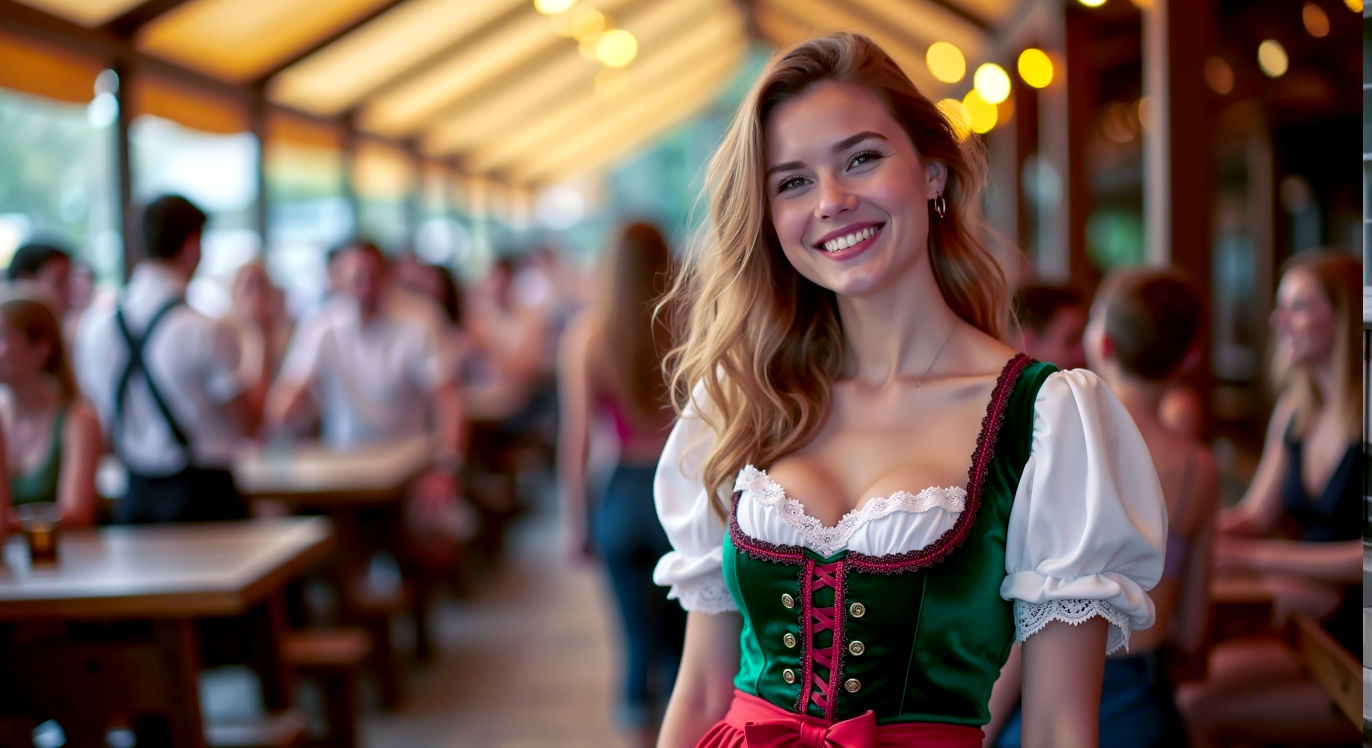The Iconic Dirndl Dress: A Guide to Germany and Austria’s Most Famous Folk Costume
From Alpine workwear to Oktoberfest icon, explore the rich history of the Dirndl. This guide explains everything a British reader needs to know.

This post may contain affiliate links. If you make a purchase through these links, we may earn a commission at no additional cost to you.
Picture this: it’s a crisp autumn day in Munich. The air is filled with the scent of roasted almonds and the cheerful sounds of a brass band. All around you, people are celebrating, raising enormous glasses of beer, and singing along to traditional tunes. And nearly every woman, from young girls to their grandmothers, is wearing a stunning, colourful dress that seems to capture the very spirit of the occasion. This is the Dirndl, and if you’ve ever seen a picture of Oktoberfest, you’ll know exactly what we’re talking about.
But the Dirndl is so much more than just a party outfit for the world’s biggest beer festival. It’s a garment steeped in history, a symbol of regional pride, and a piece of folk culture that has survived for centuries. It’s a dress that tells a story—of Alpine farmhands, high-society ladies, and the enduring traditions of Germany and Austria.
For us Brits, it might seem a bit like something out of The Sound of Music, a charming but old-fashioned costume. Yet, the Dirndl is experiencing a massive comeback. It’s not just for folk festivals anymore; it’s a fashion statement worn at weddings, parties, and family gatherings. So, what’s the story behind this iconic dress? How did it go from humble workwear to a celebrated symbol of national identity?
In this guide, we’ll unravel the fascinating tale of the Dirndl. We’ll look at where it came from, break down all its different parts (because there’s more to it than meets the eye!), explore its cultural significance, and even give you some tips on how to choose and wear one yourself. So, grab a cup of tea (or perhaps a cheeky pint!), and let’s dive into the wonderful world of the Dirndl.
What Exactly Is a Dirndl? Unpacking the Alpine Uniform
At first glance, a Dirndl looks like a single dress, but it’s actually a beautiful ensemble made up of several distinct pieces worn together. Think of it like a classic British suit—each part has a name and a purpose, and they all have to work together to create the final look. The complete outfit is more than the sum of its parts, creating a silhouette that is instantly recognisable and famously flattering for all body shapes.
Traditionally, a full Dirndl consists of three main components: the dress itself (which includes the bodice and skirt), a blouse, and an apron. Let’s break them down.
The Heart of the Outfit: The Dress (Bodice and Skirt)
The main part of the outfit is the dress, which is itself made of two connected pieces: the bodice and the skirt.
The Bodice (Mieder):
This is the close-fitting top part of the dress. It’s a bit like a waistcoat or a corset, designed to be snug around the torso, creating a structured and feminine shape. Historically, the bodice was stiffened to provide support, much like the stays worn by women across Europe for centuries. Today, they are made from a wide range of materials, from simple cotton and linen for everyday wear to luxurious silk, velvet, or brocade for special occasions. The neckline is a key feature and comes in various styles. You might see a classic square neckline, a romantic sweetheart shape, or a more modest high-necked design. The bodice is typically fastened at the front with hooks, buttons, or a zip, which is often cleverly hidden. A decorative chain or ribbon is sometimes laced through eyelets on the front, adding a touch of traditional charm.
The Skirt (Rock):
Attached to the bodice at the waist is the full, swinging skirt. The skirt is gathered or pleated into the waistline, which gives it its characteristic volume. This design was practical for working women in the past, allowing for freedom of movement. The length of the skirt has changed over the years. Traditional Dirndls were long, often reaching the ankle, which was a sign of modesty. In the mid-20th century, hemlines rose, and today you can find Dirndls in all lengths, from the classic long style (often called ‘maxi’) to the popular midi-length that sits just below the knee, and even shorter mini-Dirndls for a more modern, playful look. Underneath the skirt, many women wear a petticoat or underskirt to give it extra puff and bounce.
The All-Important Blouse (Bluse)
Underneath the bodice, a special blouse is worn. You might think any white blouse would do, but the Dirndl blouse is unique. It’s usually quite short, often ending just under the bust, as the rest of it would be hidden by the tight-fitting bodice anyway. Its main job is to frame the neckline and show off its pretty sleeves.
The sleeves are where you can really see some variety. They can be short and puffy, straight, or fitted three-quarter length sleeves. The neckline of the blouse is just as important and is designed to complement the cut of the bodice. It can be high-necked with a little collar, a simple scoop neck, or a more revealing off-the-shoulder style. The fabric is typically a lightweight cotton or lace, often decorated with delicate embroidery or ruffles. Choosing the right blouse can completely change the feel of the Dirndl, making it look either modest and traditional or modern and flirtatious.
More Than Just an Accessory: The Apron (Schürze)
The final piece of the puzzle is the apron, and it’s far from a simple cover-up to protect the dress from spills. The apron is a crucial, decorative part of the outfit. It’s made from a contrasting or complementary fabric and is tied around the waist over the skirt. Like the dress itself, aprons can be simple and plain or incredibly ornate, featuring intricate embroidery, patterns, or lace.
But the apron isn’t just for show. It holds a secret code. The way a woman ties the bow of her apron is said to signal her relationship status. This is a fun tradition that’s still widely followed today, especially during Oktoberfest. Here’s how it works:
- Bow tied on the left: This means the woman is single and possibly open to being approached. Think of it as “left for luck.”
- Bow tied on the right: This indicates she’s in a relationship, married, or otherwise spoken for. In other words, “hands off!”
- Bow tied at the front centre: This traditionally signifies that the woman is a virgin. It’s less common to see today but is part of the original custom.
- Bow tied at the back centre: This signals that the woman is a widow. It can also be worn by waitresses working at festivals.
While it started as a bit of fun, this ‘apron code’ is a well-known part of Dirndl etiquette, so it’s worth paying attention if you find yourself at a German festival!
From the Alps to the Catwalk: A Journey Through Dirndl History
The Dirndl we see today, with its vibrant colours and fine fabrics, has come a long way from its humble beginnings. Its story starts not in the grand ballrooms of Vienna, but in the rugged Alpine countryside of Austria and Bavaria in the 18th and 19th centuries.
The Servant’s Uniform
The word ‘Dirndl’ is actually a diminutive of ‘Dirn’, which means ‘girl’ in the Bavarian dialect. The term ‘Dirndlgewand’ translates to ‘girl’s dress’ and originally referred to the practical work clothes worn by female servants and farmhands. This early version was a far cry from the fancy outfits of today. It was made from durable, hard-wearing fabrics like linen and thick cotton, designed to withstand the rigours of manual labour. The colours were muted and earthy, often dyed with natural pigments from plants and minerals.
This was a uniform born out of necessity. The full skirt allowed for easy movement when working in the fields or the house, while the apron protected the dress from getting dirty. Every region had its own slight variations in style, fabric, and colour, which acted as a sort of local identifier. You could often tell where a woman was from just by looking at her dress.
An Unlikely Royal Endorsement
So how did this simple servant’s dress become a beloved national costume? We have the European aristocracy to thank for that. In the late 19th century, there was a growing fascination with romantic, rural life across Europe. City dwellers, including the upper classes, became enchanted by the idea of the simple, pure life of the countryside. This was part of the wider Romantic movement, which celebrated nature and folklore.
Around the 1870s, Emperor Franz Joseph I of Austria, who loved to spend his holidays in the picturesque Salzkammergut region, began to adopt traditional Alpine clothing, like the Lederhosen for men. The ladies of his court soon followed his lead, and the simple work dress of the local women was suddenly in vogue. They took the basic design of the Dirndl and elevated it, using luxurious materials like silk, satin, and fine printed cotton. They added intricate embroidery, lace, and other decorative flourishes.
The Dirndl had been transformed. It was no longer just a uniform for the working class; it had become a fashionable statement for high society, worn during their summer holidays in the mountains. This aristocratic seal of approval cemented the Dirndl’s place as a cherished piece of cultural heritage.
A Controversial Chapter: The Dirndl in the Nazi Era
The Dirndl’s history, like much of German and Austrian history, has a darker chapter. During the Nazi regime in the 1930s and 40s, the dress was co-opted as part of the party’s propaganda machine. It was promoted as the ideal attire for the German woman, embodying a romanticised, purely ‘Aryan’ vision of tradition and motherhood.
The Nazis sought to strip the Dirndl of its regional diversity and religious influences, standardising it to fit their ideology. They presented it as an ancient, timeless folk costume, conveniently ignoring its relatively recent adoption by the upper classes. This period tainted the dress for many, associating it with a nationalist and exclusionary agenda. After the war, the Dirndl fell out of favour for a time, seen by some as a symbol of a painful past.
The Post-War Revival and Modern Renaissance
It took several decades for the Dirndl to shake off its wartime associations and reclaim its place in mainstream culture. The turning point came in the latter half of the 20th century. The rise of tourism, particularly around events like Munich’s Oktoberfest, played a huge role. Visitors from around the world flocked to Bavaria and fell in love with its charming traditions, including the Dirndl.
Designers began to reinvent the dress for a modern audience. They played with new fabrics, shorter hemlines, and contemporary patterns, while still respecting the traditional three-piece structure. Today, the Dirndl is more popular than ever. It has become a symbol of regional pride and a way for younger generations to connect with their heritage in a fun and fashionable way. It is a fixture at folk festivals, but it’s also worn at weddings, family celebrations, and even as a chic alternative to a cocktail dress.
The modern Dirndl is a beautiful blend of tradition and innovation. You can find everything from historically accurate designs made with traditional methods to high-fashion interpretations from top European designers. This ability to evolve while staying true to its roots is the secret to the Dirndl’s enduring appeal.
The Dirndl in Culture: More Than Just a Dress
The Dirndl is not just an item of clothing; it’s a living piece of culture. It represents a connection to a specific place, a shared history, and a set of traditions that are still very much alive today. Its role in society is most visible during the many folk festivals, or Volksfeste, that take place throughout the year in southern Germany and Austria.
The Star of Oktoberfest
When you think of the Dirndl, the first thing that probably comes to mind is Oktoberfest. This massive festival, held every year in Munich, is the world’s largest Volksfest, attracting millions of visitors. And for many attendees, dressing the part is half the fun. Walk through the festival grounds, and you’ll be surrounded by a sea of Dirndls and Lederhosen.
For the locals, wearing traditional dress (Tracht) to Oktoberfest is a way of honouring their Bavarian heritage. For tourists, it’s a way to fully immerse themselves in the festive atmosphere. The sight of thousands of people in their traditional finery, singing and celebrating together, is a powerful symbol of community and shared culture. It’s no longer seen as a costume but as the official uniform of the festival.
Beyond the Beer Tent: A Dress for All Occasions
While Oktoberfest is its most famous stage, the Dirndl is worn at countless other events. In rural areas, it’s still common to see women wearing a Dirndl for Sunday church services, local parades, or village festivals. It’s also a popular choice for significant life events.
- Weddings: A Dirndl wedding is a beautiful sight. Brides often wear stunning white or cream-coloured Dirndls made from exquisite materials like silk and lace. The groom and guests also dress in traditional attire, making for a wonderfully festive and personal celebration.
- Family Celebrations: From milestone birthdays to baptisms and First Communions, the Dirndl is often worn to mark important family occasions. It’s a way of adding a touch of tradition and formality to the day.
- Regional Festivals: Every region has its own calendar of festivals, from the Cannstatter Volksfest in Stuttgart to the Vienna Woods Festival. At these events, you’ll see a dazzling array of local Dirndl styles, each with its own unique colours and patterns that reflect the specific traditions of that area.
A Symbol of Identity and Belonging
In an increasingly globalised world, the Dirndl offers a tangible connection to local identity. Wearing one can be a powerful statement of belonging, a way of saying, “This is where I come from, and I’m proud of it.” For many Germans and Austrians, especially those living abroad, putting on a Dirndl is a way to connect with their roots and celebrate their heritage.
It’s this deep cultural resonance that has allowed the Dirndl to survive and thrive. It’s a dress that carries the stories of generations, a symbol of a culture that values tradition, community, and, of course, a good celebration.
Choosing Your Perfect Dirndl: A Practical Guide
So, you’ve been invited to an Oktoberfest-themed party, or maybe you’re planning a trip to Germany and want to join in the fun. The idea of buying a Dirndl is exciting, but it can also be a bit daunting. With so many styles, colours, and price points, where do you even start? Here are some practical tips to help you find the perfect Dirndl.
Quality Over Costume
The first and most important rule is to avoid cheap, costume-shop Dirndls. These are often poorly made from shiny, synthetic materials and look more like a panto outfit than an authentic garment. They might seem like a bargain, but they won’t look or feel right, and the locals will spot it a mile away.
Instead, invest in a proper Dirndl from a reputable seller. A well-made Dirndl is a timeless piece that you can wear for years. Look for natural fabrics like cotton, linen, or a good-quality blend. The bodice should be lined, and the stitching should be neat and strong. A good Dirndl will feel comfortable and sturdy.
Finding the Right Fit
The fit is everything when it comes to a Dirndl. The most crucial part is the bodice. It should be very snug, but not uncomfortably tight. It’s designed to lift and support the bust, creating that classic hourglass silhouette. When you try it on, you shouldn’t have any gaping at the front or around the arms. It should feel like a firm hug. Don’t be afraid to go for a tighter fit than you’re used to; the fabric will often give a little with wear.
The skirt length is a matter of personal preference, but the most classic and versatile option is the midi-length, which typically falls somewhere around the knee. This length is flattering on almost everyone and is appropriate for any occasion. Ankle-length Dirndls are very traditional and elegant, while mini-Dirndls are a fun, modern choice, though they might not be suitable for more formal events.
Expressing Yourself with Colour and Style
This is the fun part! Dirndls come in a dazzling array of colours and patterns. There are no hard and fast rules here, so you can choose a style that reflects your personality.
- Traditional vs. Modern: Traditional Dirndls often feature classic patterns like small flowers, checks, or paisley, in more subdued, earthy colours. Modern designs might use bolder colours, larger prints, or even unconventional fabrics like denim.
- Colour Psychology: Think about what colours you enjoy wearing. Deep reds, forest greens, and rich blues are classic choices that always look elegant. Pinks, lilacs, and pastel shades can create a softer, more romantic look.
- Mixing and Matching: Remember that the Dirndl is a three-part outfit. You can create different looks by changing the blouse or the apron. Having one high-quality dress and a couple of different blouses and aprons gives you a surprisingly versatile wardrobe. A simple cotton apron creates a casual, everyday look, while a silk or lace apron instantly dresses it up for a special occasion.
Don’t Forget the Finishing Touches: Accessories
The right accessories complete the look and add a personal touch.
- Shoes: Traditionally, Dirndls are worn with sturdy, low-heeled shoes, a bit like Mary Janes. But today, many women pair them with ballet flats, loafers, or even smart ankle boots. The key is comfort, especially if you’ll be on your feet all day at a festival. Avoid stilettos, as they don’t fit the rustic aesthetic and are impractical for walking on grass or cobblestones.
- Jewellery: A simple necklace, often a choker-style made of velvet with a small pendant called a Kropfkette, is a classic choice. Small earrings and a bracelet can also add a nice touch.
- Cardigan or Shawl: For cooler weather, a knitted wool cardigan or a traditional shawl is the perfect way to stay warm without hiding the beautiful dress.
- Handbag: A small felt or leather handbag, or even a little woven basket, is the ideal accessory to carry your essentials.
Where to Buy Your Dirndl
If you’re in Germany or Austria, you’ll find specialist shops (Trachtengeschäfte) in most towns and cities. These are the best places to go for expert advice and high-quality garments. Major department stores also have excellent sections dedicated to traditional wear.
If you’re buying online from the UK, look for reputable brands that specialise in Tracht. Some well-known names include Krüger, Moser, and Wenger. Read reviews, check the size charts carefully (European sizing can be different), and don’t be afraid to contact customer service with questions. It’s an investment, so you want to get it right.
The Enduring Charm of a Folk Icon
The Dirndl is a remarkable garment. It’s a dress that has travelled from the Alpine pastures to the world’s most famous festivals, a piece of clothing that has been a servant’s uniform, a royal fashion statement, and a symbol of national pride. It has survived changing fashions and navigated a complex history to emerge as a beloved and vibrant part of modern culture.
More than just a dress, the Dirndl is a celebration of heritage. It’s a connection to the past and a statement of identity in the present. It embodies a love of tradition, a sense of community, and the simple joy of dressing up for a special occasion.
So, the next time you see a woman in a Dirndl, whether it’s at Oktoberfest or just in a photograph, you’ll know that you’re looking at more than just a pretty dress. You’re looking at a piece of living history, a story woven in fabric and thread, and a timeless icon of German and Austrian culture. And who knows, you might even be inspired to try one on yourself.
Further Reading
For those interested in exploring the world of Tracht further, here are some excellent resources:
- Official Oktoberfest Website (oktoberfest.de): Provides a wealth of information about the festival’s traditions, including advice on what to wear.
- Salzburger Heimatwerk: A respected institution dedicated to preserving Austrian folk culture, offering authentic Tracht and insights into its history.
- German National Tourist Board (germany.travel): Features articles and guides on German culture, traditions, and festivals where the Dirndl is celebrated.






